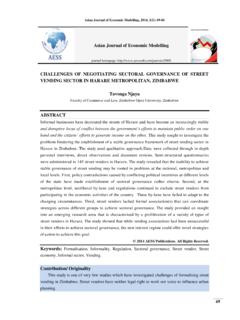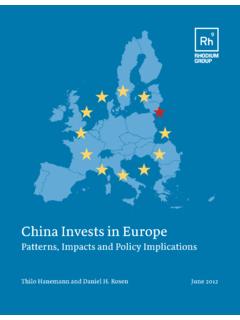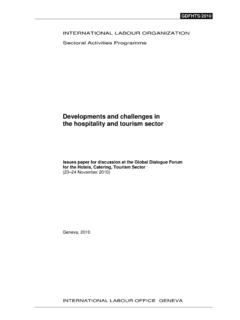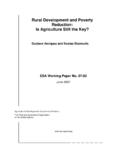Transcription of Strategic Public Management as Holistic Approach …
1 1 Strategic Public Management as Holistic Approach to Policy Integration Reinhard Steurer & Vienna University of Economics and Business Administration Research Focus Area Managing Sustainability Augasse 21/6 1091 Vienna Austria Keywords: Public Management , administrative policy, Strategic Management , Strategic Public Management , New Public Management , Environmental Policy Integration (EPI), Sustainable Development, Sustainability Abstract Policy integration is very much about how political decisions are reached and implemented. Although policy integration addresses a broad understanding of governance, the issue is often addressed in a relatively narrow sense. Scholars and practitioners are addressing policy inte-gration most often by discussing particular policy instruments or mechanisms, rather than new, more appropriate patterns of governance or administrative narratives in general. In this paper I advocate that policy integration on a broad scale requires a Holistic Approach , a new narrative of the Public sector.
2 Since the most important narratives of Public administra-tion, the models of bureaucracy, New Public Management and New Governance, all fail to address the quest for policy integration adequately, I propose Strategic Public Manage-ment (SPM) as Holistic administrative Approach . Strategic Public Management addresses the issue of policy integration more adequately than any other administrative narrative because of two reasons: The concept seeks to combine the advantages of bureaucracies, NPM and New Governance to a hybrid pattern of governance and it advocates to strengthening the Strategic capacity in the Public sector. Strategic Public Management (or a similarly hybrid administra-tive Approach ) could be for the challenge of policy integration what New Public Management was (and to a certain degree still is) for the quest for efficiency. 21. Policy Integration and Public Administration The quest for a stronger integration of different policy fields, also referred to as horizontal integration , is as old as the division of labour in governments in the form of ministries or de-partments (Peters 1998).
3 Since environmental issues are considered as distinct policy field they are often perceived to conflict with objectives in other, more traditional policy fields such as economic growth (Steurer 2002). As a consequence, environmental issues are often handled rather as appendix than as central part of other policy fields, although they are highly relevant from an environmental point of view. Transportation policies, for example, often ig-nore environmental policy objectives set by the same government. Even the rise of the con-cept of sustainable development in the course of the 1990s, which expanded the concept of policy integration in various respects (Steurer 2004), was not able to change the policy inco-herence prevalent so far. Thus, policy integration, both horizontally ( between the minis-tries within a government) and vertically ( between different levels of government), is widely regarded as key principle on the way to sustainable development (OECD 2001 Lenschow 2002; Martinuzzi & Steurer 2003).
4 Despite the fact that the challenge of policy integration is very much about how political deci-sions are reached and implemented, about a broad notion of governance (Peters 2000), the issue is often addressed in a relatively narrow sense. Both scholars and practitioners address the issue of policy integration often by discussing particular policy instruments (such as Envi-ronmental Fiscal Reforms) or mechanisms (such as inter-ministerial co-ordination structures) rather than by exploring new, more appropriate patterns of governance or administrative nar-ratives in general. However, since policy integration strongly depends on better co-ordination on the administrative level of government, I advocate that the challenge cannot be met with-out an adequate administrative pattern in place. Like the quest for efficiency in the Public sec-tor which was addressed by the narrative known as New Public Management (NPM), the issue of policy integration requires a similarly comprehensive, yet different narrative of Public administration.
5 This paper links the issue of policy integration with the study of Public administration by de-veloping the following two strings of argumentation: First, I show that none of the three exist-ing administrative narratives, classical bureaucracies, New Public Management and New Governance , address the issue of policy integration in an adequate way. Second, a hybrid pattern of governance, seeking to combine the strengths of all three administrative narratives in a problem-driven way, is put forward as comprehensive response to both, horizontal and vertical integration. This Approach , largely known in its components, but innovative in its comprehensiveness, is referred to as Strategic Public Management (SPM). As hybrid ap-proach, Strategic Public Management neither rejects nor substantially transforms one of the three existing narratives. Instead, it offers a way of reconciling them to a diverse yet coherent pattern of governance, serving not only the governance principle of integration, but also the ones of effectiveness, efficiency and accountability.
6 Since the details of NPM reforms differ strongly from country to country because of tradi-tional and structural particularities (Ara jo 2001; Christensen et al. 2002), and even from dec-ade to decade because the concept is in flux (sometimes leading to conceptual contradictions even within a country), and since the same can be assumed for New Governance and for Stra-tegic Public Management , this paper briefly characterises the administrative narratives as ideal-types in very general terms. The purpose of the paper is not to describe the particulari-ties of various administrative policy approaches for different countries and times, but to raise awareness for the need and the potential of an administrative narrative that is tailor-made for 3the challenge of policy integration. Metaphorically speaking, the paper is rather a landscape painting than a portrait. The two strings of argumentation outlined above are laid out as follows: Section 2 briefly de-scribes the changing nature of the study and the practice of Public administration over the last few decades.
7 Section 3 describes the three existing narratives of Public administration and shows how they (fail to) tackle the issue of policy integration. Because bureaucracies, NPM and New Governance have in common that they are not geared toward cross-sectoral chal-lenges, Strategic Public Management is proposed as adequately integrative Approach in sec-tion 4. Section 5 offers a brief discussion of Strategic Public Management . 2. Administrative reforms as response to governance challenges The administrative branch of the Public sector is generally perceived as embodiment of stabil-ity in at least two respects. First, regarding personnel administrators are appointed officials who serve elected officials ( politicians) from different political parties. While the former keep their office often for a lifetime (and therefore constitute a strong institutional memory), the latter change frequently. Second, regarding structure, the administrative branch of gov-ernment is often perceived as sluggish apparatus which is protected from competition and, as a consequence, from the pressure to change.
8 However, at last since the emergence of the con-cept known as New Public Management in the early 1980s, administrations have been subject to change on an ongoing basis. Since then administrative reform, reshaping the notion, struc-ture and mechanism of Public governance, is widely recognized as one of the major chal-lenges of our time (Christensen et al. 2002; Jann 2002, 2003); or as Jackson (2001, 5) puts it with regard to a more recent wave of reform referred to as New Governance , Today there is a search for a new understanding of the role and function of democratic government and along with it an answer to the question how best might the institutions of government add value to the services that they provide? . This section briefly points out the political relevance of administrative ideas and gives a first glimpse on how the notion of Public administration has changed over the last few decades. Like with other policy fields, administrative policy is continuously shaped by ideas, which are often condensed to a dominating narrative.
9 Such narratives provide a coherent picture about fundamental problems, objectives, solutions and actors in a particular policy field. As cogni-tive reference points , narratives reduce complexity, define the scope of possible actions and provide normative justifications to defend or to prevent change (Jann 2003, 97). As Kuhn (1962/1970) has pointed out for the natural sciences and as others have shown for the social sciences (for the field of macro-economic policy, see, , Hall 1989, 1993; Steurer 2002), dominant narratives or paradigms adapt to changes or are replaced by new ones whenever anomalies are perceived. Anomalies may be due to changing societal circumstances, newly emerged problems or altered problem As Werner Jann (2003, 115, 105) con-cludes in a study about governance in Germany, the same is true for administrative policy: Narratives change because of practical experiences and a cumulative learning process.
10 Between the 1920s and the 1980s, the classical model of bureaucracy as characterised by the sociologist Max Weber was the predominant paradigm of the Public sector. Its remarkable continuity over 60 years certainly fostered the perception of a Public sector relatively immune to change. However, around the 1980s, the rising perception of an inefficient Public sector 1 The shift from Keynesian to Neo-liberal growth policies was, , mainly due to the neither expected nor predicted concurrence of inflation and stagnation during the so called oil crisis in the first half of the 1970s, and to ever rising Public expenditures (even in times of strong economic growth). 4challenged the well established bureaucratic narrative. New Public Management (NPM) both popularised and tackled this administrative failure by triggering a significant change in Public administration let s say from Bureaucratism to Managerialism (Gray & Jenkins 1995).







